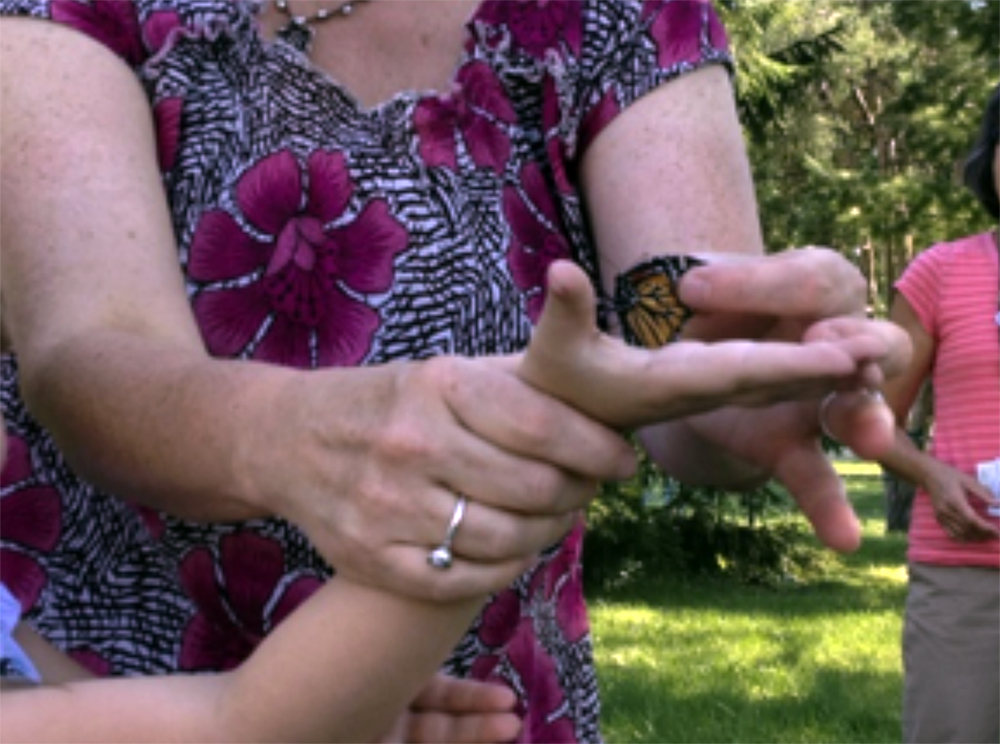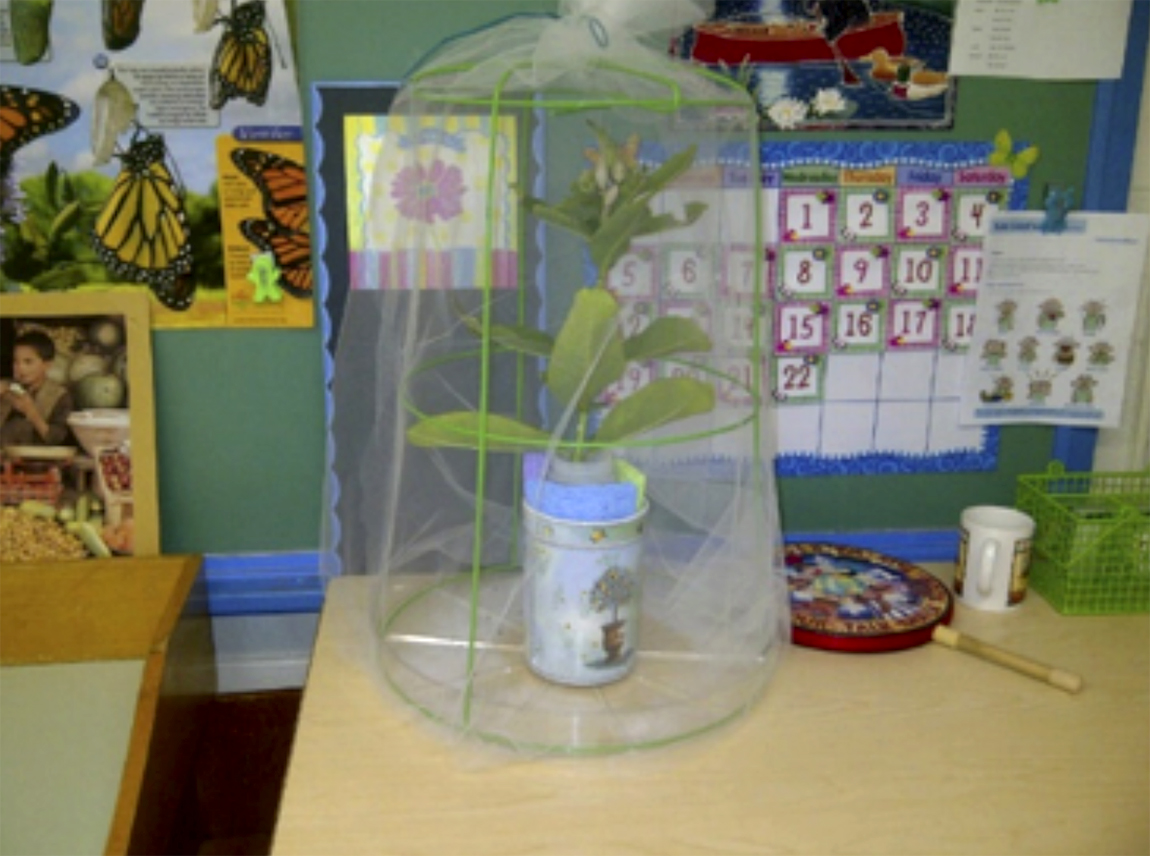Chapter 5: Collaborative-Interactive Nonfiction Writing: Positioning Students with Significant/Multiple Disabilities As Nonfiction Writers
5.2 Bringing The Natural World Into Our Classroom

While we are able to observe a great deal through our classroom window, there are times when I bring the natural world right into my classroom! Raising monarch butterflies is an activity which provides an authentic, real-world learning experience that engages my students in the science curriculum and inspires and supports nonfiction writing. As we begin this project, I order monarch larvae from Monarch Watch, set up our monarch emergence cages, and provide fresh milkweed for the monarch larvae to eat. Over the next several weeks my students observe the monarchs as they progress through the stages of their life cycle (larva, pupa, adult). Then, if all goes well, at the end of the project my students act as “citizen scientists” (through the Monarch Watch program) as we tag and release the adult monarch butterflies. This is part of a global conservation effort that includes researchers tracking the migration patterns of the monarchs.
Throughout our monarch study, we record our observations, measuring the growing larvae, estimating how much milkweed they are eating, and researching information about their life cycle, metamorphosis, and migration. When the larvae fail to develop, we try to discover why this is happening. If all goes well, in 3-4 weeks we will go outside on the playground to tag and release our adult monarch butterflies. Once again, I use children’s literature to help my students develop background knowledge and academic vocabulary as they learn about the monarch life cycle and their amazing fall migration to Mexico. Their expertise grows as we read Butterflies on Carmen Street by Monica Brown, Monarch and Milkweed by Helen Frost and Leonid Gore, and Citizen Scientists: Be a Part of Scientific Discovery from Your Own Backyard by Loree Griffin Burns, as well as high quality Web-based resources, such as Annenberg Learner’s Journey North.
As you might imagine, there are many opportunities for nonfiction writing associated with raising and releasing monarchs. This writing may be as simple as noting observations or as complicated as describing the step-by-step process of a science lesson on monarch butterflies. Much of this writing occurs in our butterfly journals. Each student has their own journal, which can be a spiral notebook or a digital version using our “notebook” software. Using this electronic technology makes the writing process more accessible for students with sensorimotor impairments although I still usually print the pages of these digital journals daily so that students can also have the more traditional paper journal. We observe our butterfly larvae, take photographs, and research information on the Web to learn about the monarch life cycle, migration, and conservation. Because many of my students are unable to physically write independently, they may type text from a model, work with a peer or adult assistant, or write in the context of a collaborative group. I provide visual models and step-by-step cues as needed. In essence, I provide my students with whatever type of support they need to be actively engaged in the writing process. Thus, through their individual writing and our use of digital photography, students visually documented the metamorphosis of the monarchs and created an artifact (their journals) that reflected their learning.
At the same time, I also create a classroom journal which is displayed as both a model for their own writing as well as a text of our shared experiences. Early in our monarch study, we took a photograph of our emergence cage, which we had researched and constructed together. I recorded my students’ observations and ideas, and together we wrote about it using chart paper as well as our classroom technology.

Today we made a cage for our monarch larvae. We used a tomato cage and netting material. We learned how to do this on the Monarch Watch website. We put the netting all around the tomato cage and tied it on top with some yarn. We have to put a lot of milkweed in there every day. That’s the only thing monarch larvae will eat. They are very picky eaters!
As we observed the monarch larvae daily, we continued to record our observations. Much of what my students wrote reflected simple observations:
“The caterpillars are eating a lot of milkweed.”
“They are growing a lot.”
“They are getting longer.”
“They are getting fatter.”
“My caterpillar made its chrysalis today!”
Finally, on a beautiful, sunny day in late September, I took a group of students outside on the playground to release our adult monarch butterflies. Each student had an opportunity to say something to the monarchs before we released them.
When we returned to our classroom, we collaborative composed and typed this brief piece describing our ceremony:
Butterfly, you are very beautiful! We wish you safe travels to Mexico. Please take some time to rest before you go. Mexico is a long way away. Migration is hard work! You have a very long journey ahead of you.
This process of bridging nonfiction writing with scientific inquiry is a lot of work as it takes place in the context of managing 6-8 students with significant/multiple disabilities. It takes up my personal time in the evenings and weekends as I drive around in search of milkweed along highways and construction sites. Needless to say, there have been many times when I have questioned whether it is worth all of the trouble, but in the end I always reach the same conclusion – it is definitely worth the trouble! Of course, things do not always go smoothly: the larvae may fail to develop; there is never enough time in the school day for meaningful observation and reflection; and we are constantly interrupted by therapies and various medical procedures. Yet despite all these frustrations, this experience provides rich opportunities for learning and nonfiction writing. In fact, it is often this study which grounds us.
Through our collaborative, hands-on approach to nonfiction writing tied to a science unit on butterfly metamorphosis, my students with significant/multiple disabilities constructed their knowledge about monarchs and communicated their understandings to others via butterfly journals, photographs, and text. They wrote in academic language and used grade-appropriate, content vocabulary; further they included non-textual nonfiction features in their pieces to communicate what they knew about this topic.